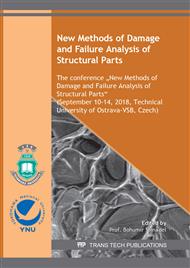[1]
BS (British Standards) 7910, Guide to Method for Assessing the Acceptability of Flaws in Metallic Structures, London, (2005).
Google Scholar
[2]
ASME (American Society of Mechanical Engineers) Code Section VIII, Div. III, Fracture Mechanics Evaluation, Article KD-4, New York, (2015).
Google Scholar
[3]
A. Hobbacher, Recommendations for Fatigue Design of Welded Joints and Components, International Institute of Welding, IIW XIII-2151-07/XV-1254-07, (2007).
DOI: 10.1007/978-3-319-23757-2_8
Google Scholar
[4]
ASTM (American Society of Testing Method) E 647-00, Standard Test Method for Measurement of Fatigue Crack Growth Rates, Philadelphia (2001) 628-670.
Google Scholar
[5]
K. Hasegawa and S. Usami, Technical Basis of Fatigue Crack Growth Threshold for Stainless Steel in Air Environment for ASME Code Section XI, ASME PVP2017-66205, July 2017, Waikoloa, Hawaii, USA.
DOI: 10.1115/pvp2017-66205
Google Scholar
[6]
K. Hasegawa and B. Strnadel, Definition of Fatigue Crack Growth Thresholds for Ferritic Steels in Fitness-for- service Codes, ASME PVP2018-84940, July 2018, Prague, Czech.
DOI: 10.1115/pvp2018-84940
Google Scholar
[7]
S. Usami, Development of Fracture Mechanics Evaluation Methods for Some Fatigue Problems of Machine Structures, Dissertation,1982, Tokyo University.
Google Scholar
[8]
K. Hasegawa and S. Usami, Effect of Stress Ratio on Fatigue Crack Growth Threshold for Austenitic Stainless Steel in Air Environment, Key Engineering Materials, 741 (2017) 88-93.
DOI: 10.4028/www.scientific.net/kem.741.88
Google Scholar
[9]
N. E. Frost, L.P. Pook and K. Denton, A Fracture Mechanics Analysis of Fatigue Crack Growth Data for Various Materials, Engineering Fracture Mechanics, 3(1971)109-126.
DOI: 10.1016/0013-7944(71)90003-8
Google Scholar
[10]
R. A. Schmidt and P. C. Paris, Thresholds for Fatigue Crack Propagation and the Effects of Load Ratio, ASTM STP 536 (1973)79-90.
Google Scholar
[11]
X-D, Li, and L. Edwards, Theoretical Modelling of Fatigue Threshold for Aluminium Alloys, Eng. Fracture Mechanics, Vol. 54, No.1 (1996)35-48.
DOI: 10.1016/0013-7944(95)00206-5
Google Scholar
[12]
C. Santus, D. Taylor and M. Benedetti, Experimental Determination and Sensitivity Analysis of the Fatigue Critical Distance obtained with round V-notch Specimens, Int. J. of Fatigue, 113 (2018) 113-125.
DOI: 10.1016/j.ijfatigue.2018.03.037
Google Scholar
[13]
J.A. Vasquez, A Quantitative Continuum Approach to Fatigue Crack Propagation, 5th National Symposium on Fracture Mechanics, Urbana, (1971).
Google Scholar
[14]
H. H. Johnson and P.C. Paris, Subcritical flaw growth, Engineering Fracture Mechanics, 1 (1968)3-45.
Google Scholar
[15]
B. M. Linder, Extremely Slow Crack Growth Rates in Aluminium alloy 7075-T6, Ms. Thesis, Lehigh University, (1965).
Google Scholar
[16]
D. Taylor, A Compendium of Fatigue Thresholds and Growth Rates, Engineering Materials Advisory Service Ltd., West Midlands, UK (1985).
Google Scholar


